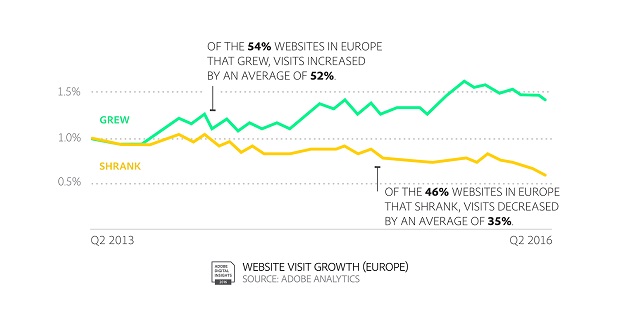Digital advertising channels remain critical for driving traffic to brand websites in Europe, generating the majority (68 percent) of website visits, a study by Adobe Digital Insights reveals.
Key findings include:
• Digital advertising channels remain critical for driving traffic to brand websites in Europe, accounting for 68% of website traffic.
• 54% of websites in Europe have grown their traffic since 2013, with growing brands seeing 2.6 times as much traffic from social advertising than websites with declining traffic.
• Personalised adverts have driven 8% growth for the brands that deploy them. But Europe is lagging behind the US, where personalised adverts caused traffic to grow by 36%.
• Nearly two in three European consumers like the personalised advertisements they receive today, however there is still work to be done: only 27% believe they are as tailored as they need to be.
The study found that just over half (54 percent) of European websites grew their traffic in the last three years, with aggregated website traffic slightly contracting during that period. The study also found that mobile advertising is catching up in Europe: Three years ago, just over half of smartphone traffic in Europe was generated by advertising; today, advertising accounts for two of every three visits from smartphones.
Europe lags behind North America in its use of more targeted or personalised advertising tactics—such as direct email, paid search, or social advertising—to drive traffic to websites: Three out of four visits to European websites are driven by non-targeted tactics such as organic search engine optimisation (SEO) or links from referral websites. European websites which grew their traffic in the last three years see 8 percent more traffic coming from personalised advertising channels than their declining counterparts. In the US, growing websites see 36 percent more traffic from personalised channels, indicating a more rapid adoption of targeted tactics in that market.
The research found that there is a correlation between website traffic growth and the use of more personalised forms of advertising: European websites with growing traffic see almost 2.6 times as much traffic from tactics like social advertising—and about 1.2 times as much traffic from paid search—than websites with declining traffic. The study showed a similar correlation with regards to mobile traffic: Growing websites in the last three years showed 50 percent more visits from smartphones than declining websites.
“Internet traffic is nearing saturation in Europe and elsewhere. The days of organic website traffic growth are coming to an end. New growth will require an evolution in thinking that revolves around a holistic consumer experience—capitalising on mobility, deploying a market mix that supports the customer journey, and creating personalised content that resonates with the customer,” said Becky Tasker, Managing Analyst at Adobe Digital Insights.
Europeans still sensitive to advertising, but looking for more personalisation
Europeans remain sensitive to advertising, the study found. Among those who use an adblocker, 44 percent said that they use one because advertisements are annoying and/or interruptive. The majority of consumers in the UK, France and Germany prefer not to watch advertisements that automatically play music or sounds, with France’s reluctance the highest (66%), followed by the UK (60%) and Germany (59%).
Meanwhile, ad-blocking in Europe is, on average, roughly comparable to the US, although it varies widely among European countries, ranging from 12 percent in France to 28 percent in Sweden. But despite their sensitivities, 40 percent of European consumers say that advertisers have gotten better over the last two years at showing them valuable and compelling advertisements. Nearly two in three European consumers like the personalised advertisements they receive today, although there is still work to be done: only 27 percent believe they are as tailored as they need to be.
Consumers also have an expectation of rewards—in the form of relevant content and special offers—in exchange for revealing information about themselves: In countries like the UK and France, over half of consumers agree with the statement that the more information they share about themselves, the more they should be rewarded with relevant content and offers, with the figure higher (nearly 60 percent on average) among younger millennials (18-24).
Adobe Digital Insights – Advertising Demand Report 2016: Europe
The report used the following data sources:
North American and European companies in select industries: Media and Entertainment, Retail, Travel, Finance, Autos & Vehicles
1.1 trillion visits from 1,100 websites from January 2013 through June 2016
Websites classified into segments based on change in number of website visits over the past three years
Growth Websites: Visits increased between Q2 2013 and Q2 2016
Shrinking Websites: Visits decreased between Q2 2013 and Q2 2016
Survey of over 4,000 US and European consumers, covering their perceptions and preferences around digital advertising and ad blocking, conducted August 2016
Ad blocking statistics courtesy of PageFair, based on data through June 2016, including number of blockers in over 21 countries on desktop and mobile devices
